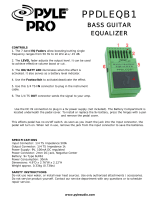
7
3 Hookup
3.1 Rear-Panel Connections
StudioLive™ 16.0.2 USB
Owner’s Manual
3 Hookup
3.1 Rear-Panel Connections
Microphone Inputs. Your StudioLive is equipped with 12 PreSonus XMAX
microphone preamplifiers for use with all types of microphones. The XMAX
preamplifier has a Class A input buffer, followed by a dual-servo gain stage. This
arrangement results in ultra-low noise and wide gain control, allowing you to boost
signals without increasing unwanted background noise.
48-volt Phantom Power. The StudioLive provides 48V phantom power for the
microphone input on each channel. This feature can be individually enabled for each
channel using the 48V button in the Fat Channel. See Section 4.1 for details.
WARNING: Phantom power is required for condenser microphones but can
severely damage dynamic mics, especially ribbon mics. Therefore, switch
phantom power off for all channels where it is not required.
Power User Tip: Dynamic microphones and ribbon microphones are generally lower-
output devices and require no external power source. The most important thing to note
about ribbon microphones is that they very rarely require phantom power. In fact, unless
a ribbon microphone calls specifically for phantom power, sending phantom power to it
can cause severe damage – probably beyond repair. Condenser microphones are
generally more sensitive than dynamic and ribbon microphones and typically require
external +48V phantom power. Always review your microphone’s documentation to
ascertain the manufacturer’s recommended operating practices.
XLR connector wiring for phantom power:
Pin 1 = GND Pin 2 = +48V Pin 3 = +48V
Line-level Input. Each channel of the StudioLive has a balanced, ¼-inch TRS
connection for line-level input. When these inputs are engaged, the microphone-
preamp circuit is bypassed. Typical examples of line-level connections are synthesizer
outputs, CD/DVD-player outputs, and (with exceptions) signal-processor outputs.
Note: As with any mixer, plugging in a microphone or a line-level input device, or turning
phantom power on or off, will create a momentary spike in the audio output of your
StudioLive. Because of this, it is highly recommended that you mute or turn down the
channel trim before changing connections or turning phantom power on or off. This
simple step will add years to life of your audio equipment.
Stereo Inputs. Channels 9 through 16 are stereo inputs. Each pair of
channels is controlled by a single fader, Solo, Mute, and Select button.
By default, Channels 9/10 through 15/16 are set to be mono, so that only
the mic and line inputs of the Left (mono) channel will be heard. When
these channels are unlinked, the Right input is not accessible on the
mixer. To insert the Right input into your mix, you must engage Stereo
Link (see Section 4.2 for details).
RCA Inputs. Channels 13/14 and 15/16 have unbalanced RCA
connections, in addition to the balanced TRS connections.
Like the TRS connections, the right RCA input will not be
accessible on the mixer if the channels are not linked.
Aux Outputs. The StudioLive is equipped with four auxiliary
outputs. In Section 5.2.4, we discuss in detail how to create aux
mixes for monitoring. Aux mixes are routed to these outputs.




















